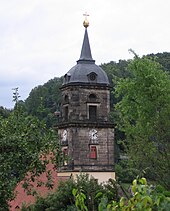Marienkirche (Königstein / Saxon Switzerland)
The Marienkirche is the Evangelical Lutheran town church in Königstein in Saxon Switzerland . The church dates back to the 15th century and its interior houses a pulpit altar in the form of a Greek portico made of sandstone .
history
Around 1450, a church was built on the Schreiberberg, today's location. After a fire in 1559 and because of its dilapidation, the building was demolished and rebuilt. From 1704 to 1724 George Bähr led the construction of a larger church together with the Dresden builders Fehre and Dünnebier. After a city fire in 1810, it was destroyed and consecrated in 1823 after being rebuilt. A new large bell was purchased in 1967 after two of the three bells for the armaments industry had been confiscated in 1940. The church was renovated in 1985 and 1992 and a golden dome cross was attached. In 1994/95 a new third bell and a bell system could be installed. During this period, all twelve church windows were also renewed.
Building description
Inside the church, elements of classicism predominate , while the exterior is characterized by the baroque . The original altarpiece "Clemens von Dippoldiswalda" was lost and was replaced in 2000 by an abstract new one by Günther Jacob from Dresden. The windows of the choir show the coats of arms of two aristocratic families from the surrounding area: von Bünau zu Possen and von Bärenstein zu Thürmsdorf . A baptismal font made of serpentine stone from Zöblitz is located in the central axis of the nave between the pulpit and the altar table. The pulpit altar in the form of a Greek temple entrance made of sandstone, which was intended for painting in 1811, is unusual for a Christian church. In the gable of the building is the triangle symbolizing God with an eye . After restoration work, the original painting and colors from 1824 were determined. From 2001 to 2003 ceilings and wall surfaces were painted in light colors from white to ocher to light blue.
organ
The organ was consecrated in 1851 and built by Johann Gotthold Jehmlich (Dresden) with 26 registers according to Silbermann's principles. In 1907 the instrument was rebuilt, u. a. to pneumatic tracker action changed and a pneumatic Swell supplemented in the tower room. She also received a crescendo roller. Since the prospect pipes had to be handed in in 1917, they were replaced by zinc pipes in 1929 and another renovation took place. The prospectus was moved 1.5 m to the rear, parts of the main work were moved into the tower room, a back positive was attached using some of the existing registers, and pedal registers were partially arranged to the side. From 2004 to 2006 the instrument was rebuilt by Georg Wünning at the old location, using pipe material from 1851 or 1907, and largely restored the external appearance of 1851 without a return positive. Today the instrument has 38 sounding registers (2447 pipes) on three manuals (main and upper works: mechanical slide box , swell mechanism: electro-pneumatic cone box) and pedal (mechanical slide box).
|
|
|
|
||||||||||||||||||||||||||||||||||||||||||||||||||||||||||||||||||||||||||||||||||||||||||||||||||||||||||||||||||||||||||||||||||||||||||||||||||||||||||||||||||||||||||||||||||||||||||||||||
- Remarks:
- H = historical register from 1851 or 1907
Peal
The ringing consists of three bronze bells , the bell cage is made of oak, as are the bell yokes . Below is a data overview of the bell:
| No. | Casting date | Caster | material | diameter | Dimensions | Chime |
|---|---|---|---|---|---|---|
| 1 | 1967 | Bell foundry S. Schilling | bronze | 1189 mm | 900 kg | it' |
| 2 | 1994 | Bell foundry HM Rinker | bronze | 1042 mm | 672 kg | ges ′ |
| 3 | 1922 | Bell foundry B. Pietzel | bronze | 784 mm | 267 kg | b ′ |
literature
- Rainer Thümmel : Bells in Saxony . Sound between heaven and earth. Ed .: Evangelical Regional Church Office of Saxony . 2nd, updated and supplemented edition. Evangelische Verlagsanstalt, Leipzig 2015, ISBN 978-3-374-02871-9 , p. 305 (With a foreword by Jochen Bohl and photographs by Klaus-Peter Meißner}).
Web links
Individual evidence
- ↑ Information sheet of the parish of Königstein-Papstdorf 2011
- ↑ More information about the organ. (No longer available online.) Archived from the original on December 6, 2014 ; Retrieved December 5, 2014 .
- ^ A b Rainer Thümmel : Bells in Saxony . Sound between heaven and earth. Ed .: Evangelical Regional Church Office of Saxony . 2nd, updated and supplemented edition. Evangelische Verlagsanstalt, Leipzig 2015, ISBN 978-3-374-02871-9 , pp. 305 (With a foreword by Jochen Bohl and photographs by Klaus-Peter Meißner).
Coordinates: 50 ° 55 ′ 5.9 ″ N , 14 ° 4 ′ 19.8 ″ E



